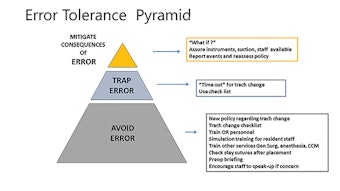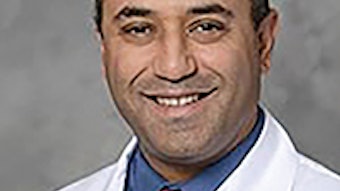Out of Committee: Endocrine Surgery Committee
Thyroid nodules are quite common and typically benign. Nonetheless they can be troubling in many ways to patients who then seek treatment, which often results in thyroid surgery. Thyroid surgery comes with some generally accepted risks, and quality of life may become significantly altered in several ways. The possible need for thyroid hormone supplementation or replacement is one of the major concerns for these patients undergoing surgery.
Radiofrequency Ablation for Benign Thyroid Nodules
Ralph P. Tufano, MD, MBA; Lisa A. Orloff, MD; Jon O. Russell, MD; Catherine Sinclair, MD
Thyroid nodules are quite common and typically benign. Nonetheless they can be troubling in many ways to patients who then seek treatment, which often results in thyroid surgery. Thyroid surgery comes with some generally accepted risks, and quality of life may become significantly altered in several ways. The possible need for thyroid hormone supplementation or replacement is one of the major concerns for these patients undergoing surgery. A new way to treat these nodules without surgery, and likely without any need for thyroid hormone medication, is with radiofrequency ablation (RFA).
Ultrasound as the Foundation to Performing RFA
The practice of ultrasonography (US) has become widespread in otolaryngology-head and neck surgery. US is invaluable not only for diagnostic applications, but also for interventional procedures in diseases affecting the thyroid, parathyroid, salivary glands, and lymph nodes. The cost-effectiveness of US, along with its point-of-care capability, dynamic assessment in real time, and lack of radiation, have contributed to its popularity. A thorough understanding of sonographic anatomy and technique are the foundation upon which appropriate patient selection and precisely guided procedures, including RFA, are based.
Thyroid pathology is the most common indication for US in the neck, and ultrasound-guided fine needle aspiration is the most frequently performed image-guided procedure for cytologic evaluation of neck masses including thyroid nodules. More than 90% of thyroid nodules are benign. About half of all adults over 50 years of age have thyroid nodules, and a proportion of these nodules cause compressive symptoms, cosmetic deformity, or hormonal imbalance. It is no wonder that thyroidectomy is one of the most commonly performed surgical procedures, with an estimated 150,000 thyroid operations per year in the United States. However, a new era of minimally invasive, nonsurgical treatment of benign thyroid nodules with RFA has dawned as an outgrowth from expertise attained in US imaging and US-guided procedures.
Office Requirements for RFA
RFA requires minimal office equipment other than an ultrasound machine with Doppler capabilities, a radiofrequency generator, and an RFA needle probe. The RFA probes are internally cooled and require continuous irrigation with cold injectable fluid (saline or dextrose). Other equipment includes local anesthesia (1% or 2% lidocaine, 10-30 mL), a 25-gauge needle, a 20-22-gauge long spinal needle, injectable dextrose 5% solution (for hydro-dissection), skin prep, and drapes.
Technique of RFA
An advantage of RFA is the basic technique is familiar to clinicians who perform ultrasound-guided thyroid biopsies. Using a traditional thyroid ultrasound device (usually 7-15MHz), the nodule is identified. Lidocaine (1%-2%) and, when necessary, 5% dextrose are used to hydrodissect along the thyroid capsule under sonographic visualization. This step is a “practice run” for the ablation and allows the clinician to make strategic ablation plan adjustments prior to inserting the larger RFA probe. An RFA probe is selected—an 18-19-gauge needle with a 7-10 mm active tip is a typical starting range. A trans-isthmic approach is utilized with the RFA probe usually entering on a line at about the midpoint of the nodule to be treated. Ablation then proceeds in a systematic fashion (moving shot technique), beginning at the deepest levels of the nodule. One must always visualize the probe tip before and during activation of the device. This helps to avoid ablating too close to critical anatomic structures, such as the trachea, esophagus, and recurrent laryngeal nerve, and to avoid a skin burn. When treated, the surrounding tissue will become hyperechoic.
During ablation the patient should be asked to vocalize at various intervals to assess vocal quality, particularly when ablating adjacent to the “danger zone” at the posteromedial thyroid capsule. Post-procedure the patient is typically given an ice pack and is able to resume most normal activity the next day. Patients should be examined by ultrasound at various time intervals (e.g., one, three, six, and 12 months post-RFA) to assess percent volume reduction and assess for nodule regrowth.
Final Thoughts
Ultrasound-guided RFA enables the otolaryngologist-head and neck surgeon to further personalize treatment for patients with benign thyroid nodules and with minimal morbidity when carefully adopted. The future is here for benign thyroid nodules with further investigation of RFA for other lesions of the head and neck on the horizon.










